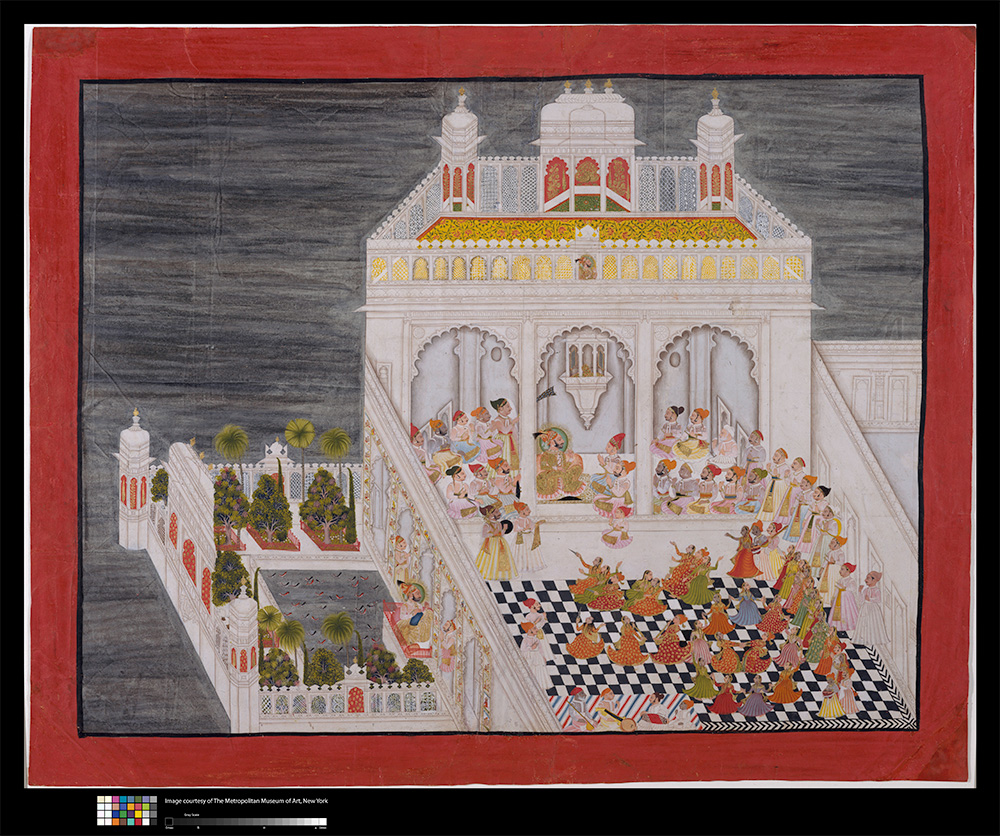
Attributed to Bhima, Kesu Ram, Bhopa, and Nathu (Indian), Maharana Ari Singh with his Courtiers Being Entertained at the Jagniwas Water Palace, 1767, India; Rajasthan, Udaipur, former Kingdom of Mewar, ink, opaque watercolors, and gold on paper, Metropolitan Museum of Art, Purchase, Mr. and Mrs. Herbert Irving, Mr. and Mrs. Arthur Ochs Sulzberger, and Mr. and Mrs. Henry A. Grunwald, gifts in honor of Mr. and Mrs. Gustavo Cisneros, 1994.116, Page: 26 5/8 x 32 7/8 in. (67.6 x 83.5 cm) Image: 22 3/4 x 29 3/16 in. (57.8 x 74.1 cm)
Verbal Description
Hello, my name is Emily Holtrop. I am the director of learning and interpretation at the Cincinnati Art Museum. I will be reading the verbal description for Maharana Ari Singh with his Courtiers Being Entertained at the Jagniwas Water Palace in Beyond Bollywood: 2000 Years of Dance in Art.
Attributed to the Indian artists Bhima, Kesu Ram, Bhopa, and Nathu, this painting, titled, Maharana Ari Singh with his Courtiers Being Entertained at the Jagniwas Water Palace is from 1767. It is from India, specifically the region of Rajasthan, Udaipur, and the former Kingdom of Mewar. It is ink, opaque watercolors, and gold on paper. It is in the collection of the Metropolitan Museum of Art and was purchased with funds from Mr. and Mrs. Herbert Irving, Mr. and Mrs. Arthur Ochs Sulzberger, and Mr. and Mrs. Henry A. Grunwald, and gifts in honor of Mr. and Mrs. Gustavo Cisneros. The accession number is 1994.116.
Maharana Ari Singh with his Courtiers Being Entertained at the Jagniwas Water Palace is a landscape oriented opaque watercolor painting with gold on paper. The image measures 57.8 x 74.1 centimeters on a 67.6 x 83.5 centimeter page. A large white structure occupies most of the image. The main architectural setting is two stories tall. The top level has a dark yellow and floral textile floor spread and is surrounded on all sides by a balustrade with arched openings covered by lattice. On the back side of this open space are a series of white-roofed towers with arched openings framed in red—one on the left corner, a larger one in the center, and another on the right. The lower level of this structure is enclosed with openings in the shape of three arches with pillars. In this space we see a large group of people made up of the Maharana and his retinue. A courtyard with a black and white checked floor in which a group of dancers and musicians perform extends out from this enclosed space. To the left of the courtyard, there appears to be a walled garden with a central pool. The Maharana is also positioned there, looking into the central checkerboard courtyard. The entire scene is painted on a dark blue sketchy background, and a painted red border frames the painting.
Label Text
Hello, my name is Emily Holtrop. I am the director of learning and interpretation at the Cincinnati Art Museum. I will be reading the label for Maharana Ari Singh with his Courtiers Being Entertained at the Jagniwas Water Palace in Beyond Bollywood: 2000 Years of Dance in Art.
Attributed to the Indian artists Bhima, Kesu Ram, Bhopa, and Nathu, this painting, titled, Maharana Ari Singh with his Courtiers Being Entertained at the Jagniwas Water Palace is from 1767. It is from India, specifically the region of Rajasthan, Udaipur, and the former Kingdom of Mewar. It is ink, opaque watercolors, and gold on paper. It is in the collection of the Metropolitan Museum of Art and was purchased with funds from Mr. and Mrs. Herbert Irving, Mr. and Mrs. Arthur Ochs Sulzberger, and Mr. and Mrs. Henry A. Grunwald, and gifts in honor of Mr. and Mrs. Gustavo Cisneros. The accession number is 1994.116.
Udaipur paintings that record dance are often situated within a grand architectural setting. This perspective incorporates dance into the larger, often performative nature of court life. Here, a large troupe of dancers crowd a checkerboard courtyard while Maharana Ari Singh is seen twice: seated formally with his retinue of noblemen and alone, watching the performance through a cusped archway. Full of movement, the dancers move or sit in small groupings, with several clutching daggers in their hands, perhaps to symbolize the importance of weaponry in the life and culture of Mewar.
Another set of dancers in this crowded performance space form a circle around a couple. Circle dances are associated with several annual festivals, including Krishna’s rasalila (dance of delight) and the dance in celebration of Shiva and Parvati at the Gangaur festival.
